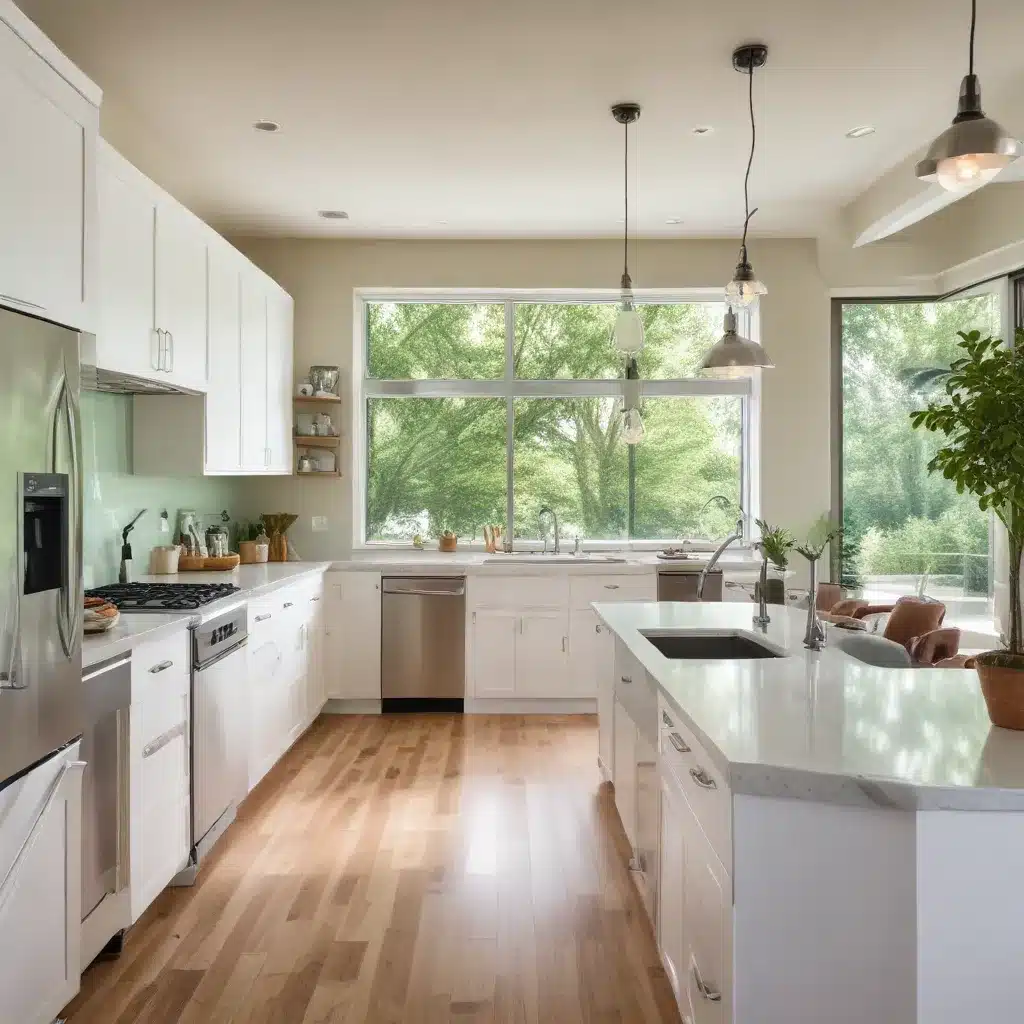
Sustainable Kitchen Remodeling: Minimizing Environmental Impact
As an experienced home improvement consultant, I’ve witnessed a growing trend towards sustainable kitchen remodeling. Homeowners are increasingly seeking ways to transform their cooking spaces in an eco-friendly manner, minimizing their environmental footprint while creating beautiful and functional kitchens. In this comprehensive guide, we’ll explore the strategies, materials, and design considerations that can help you achieve a sustainable kitchen remodel without sacrificing style or convenience.
Materials and Resources
At the core of a sustainable kitchen remodel is the careful selection of eco-friendly materials. From countertops to cabinets, flooring to fixtures, each component offers an opportunity to reduce your environmental impact. Look for materials that are renewable, recycled, or reclaimed, such as:
- Bamboo for cabinetry and flooring
- Recycled glass or concrete for countertops
- Cork for resilient, insulating flooring
- Reclaimed wood for a unique, rustic aesthetic
Sustainable sourcing practices are also crucial. Opt for locally-sourced materials whenever possible to minimize the carbon footprint associated with transportation. Additionally, consider the lifecycle of the materials you choose, selecting those that are durable and can be easily repaired or repurposed in the future.
Minimizing material waste is another key consideration. Collaborate with your contractor to develop a comprehensive waste management plan, ensuring that construction debris is properly recycled or diverted from landfills. This may involve setting up on-site sorting stations or partnering with local waste management services.
Energy Efficiency Measures
Energy efficiency is a cornerstone of sustainable kitchen design. By upgrading to ENERGY STAR-certified appliances, you can significantly reduce your kitchen’s energy consumption and utility bills. From refrigerators and dishwashers to ovens and cooktops, these high-performance models use up to 50% less energy than their conventional counterparts.
Optimizing your kitchen’s lighting is another impactful energy-saving strategy. Incorporate natural daylighting through strategically placed windows or skylights, and supplement with energy-efficient LED lighting fixtures. These measures not only reduce your energy usage but also create a more inviting and well-lit cooking environment.
Improving insulation is also essential for enhancing your kitchen’s energy efficiency. Ensure that walls, floors, and ceilings are properly insulated to minimize heat transfer and regulate the indoor temperature, reducing the need for excessive heating or cooling.
Water Conservation Techniques
Water conservation is a crucial component of sustainable kitchen design. Start by selecting water-efficient plumbing fixtures, such as low-flow faucets and ENERGY STAR-certified dishwashers. These upgrades can reduce water consumption by as much as 20% compared to older models.
Consider incorporating a greywater recycling system into your kitchen remodel. Greywater, the used water from sinks, dishwashers, and washing machines, can be treated and reused for tasks like toilet flushing or landscape irrigation, significantly reducing your overall water usage.
Drought-resistant landscaping around your kitchen can also contribute to water conservation. Opt for native, low-water-use plants that thrive in your local climate, minimizing the need for extensive irrigation.
Waste Reduction and Management
Sustainable kitchen remodeling goes beyond the selection of materials and the optimization of energy and water usage. It also encompasses effective waste reduction and management strategies.
Collaborate with your contractor to develop a comprehensive construction waste diversion plan. This may involve donating salvageable materials, recycling non-hazardous items, and properly disposing of any hazardous waste. By keeping construction debris out of landfills, you can significantly reduce the environmental impact of your remodel.
Within the kitchen itself, incorporate features that encourage composting and recycling. Designate dedicated spaces for sorting and storing food scraps, recyclables, and other waste, making it easier for your household to reduce the amount of refuse sent to landfills.
Holistic Design Considerations
Sustainable kitchen remodeling goes beyond the individual components; it requires a holistic approach that considers the overall design and functionality of the space. By embracing passive design principles, you can create a kitchen that is not only eco-friendly but also comfortable and energy-efficient.
Maximize natural ventilation through strategically placed windows and doors, and leverage thermal mass in your construction materials to help regulate indoor temperatures. Carefully plan your kitchen’s layout to optimize daylighting, reducing the need for artificial lighting.
When it comes to spatial organization, focus on creating an ergonomic and efficient kitchen design. Prioritize a work triangle layout, positioning the sink, stove, and refrigerator in a triangular configuration to minimize unnecessary movement and improve workflow. Incorporate multifunctional spaces that serve dual purposes, such as a kitchen island that doubles as a dining area or a pantry that also houses your recycling station.
The aesthetics and ambiance of your sustainable kitchen remodel should not be overlooked. Incorporate biophilic design elements, such as live plants, natural wood accents, and earthy color palettes, to create a soothing and restorative atmosphere. Aim for a timeless style that will stand the test of time, reducing the need for frequent renovations.
Budgeting and Cost Considerations
Sustainable kitchen remodeling often comes with a slightly higher upfront cost compared to traditional renovations. However, the long-term benefits in terms of energy savings, reduced maintenance, and increased home value can make these investments well worth it.
When budgeting for your sustainable kitchen remodel, factor in the higher costs of eco-friendly materials and energy-efficient appliances. Conversely, you may see cost savings in areas like reduced utility bills, lower maintenance requirements, and potential tax credits or rebates for implementing sustainable features.
Ultimately, the decision to invest in a sustainable kitchen remodel is a personal one, and the cost-benefit analysis will depend on your individual circumstances, priorities, and long-term plans for the home. Consult with a trusted home improvement contractor, like those at Reluctant Renovator, to discuss your specific needs and budget, and explore the various sustainable options available.
By embracing sustainable strategies, materials, and design principles, you can transform your kitchen into an eco-friendly haven that not only reduces your environmental impact but also enhances your quality of life and home value. With the right planning and execution, your sustainable kitchen remodel can be a rewarding investment in both your home and the planet.



